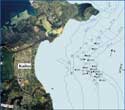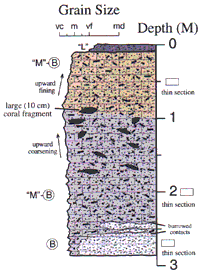
Other info:

U.S. Geological Survey
Open-File Report 03-441
Home > data > vibracores > sketches, descriptions & photographs > 2000 Kailua
 |
Other info: |
|
Vibracore 1V1, Kailua Bay Upward-fining, brownish-gray (5YR4/1), silty, very fine-grained carbonate sand layer (6-8) cm thick; vague lamination to burrowed?; burrowed lower contact. |
Click either image for larger views (302 kb)  |
 |
|
Vibracore 2V1, Kailua Bay Uniform succession of bioturbated, very fine- to fine-grained, carbonate sand; massive appearing (no obvious sedimentary structures) owing to extensive bioturbation; yellowish gray (5Y8/1); fair to moderate sorting with scattered, coarse-grained skeletal fragments (2-5%); all sand size clasts angular to subangular; sand fraction composed of a mix of Halimeda (27.5-28.0%), coral fragments (15.5-19.0%), benthic foraminifera (12.5%) and calcareous algae (8.5-9.0%) with common calcareous sponge spicules (5.0-7.5%); minor volcanic rock fragments (2.0%) also abundant unidentifiable skeletal clasts (18.0-25.5%) owing to the very fine grain size. |
Click either image for larger views (252 kb) |
|
Vibracore 3V1, Kailua Bay Uniform burrowed to bioturbated, very fine- to fine-grained, Halimeda-bearing carbonate sand; massive appearing owing probably to extensive bioturbation; yellowish gray (5Y8/1); poor to fair sorting; clasts angular to subrounded; sand composed mainly of mix of Halimeda (30.0-36.0%, coral fragments (15.5-17.5%), calcareous algal fragments (10.5-12.0%) and benthic foraminifera (4.0-14.0%),with abundant unidentifiable clasts (12.5-14.5%) owing to fine grain size, and common carbonate rock fragment grains (2.5-12.0%); also minor mollusks (3.0-3.5%), echinoderm fragments (2.0-3.5%), calcareous sponge spicules (2.0-2.5%) and altered volcanic rock fragment grains (0.5-2.5%). A relatively sharp to burrow-mottled contact. Uniform burrowed to bioturbated, very fine- to coarse-grained, carbonate sand; massive appearing owing probably to extensive bioturbation; light olive to yellowish gray (5Y6/1-8/1); very poor sorting; clasts angular to subangular; sand composed mainly of mix of coral fragments (20.5-27.5%), Halimeda (15.5-26.0%), calcareous algal fragments (18.5-20.0%) and benthic foraminifera (12.0-16.5%),with common carbonate rock fragment grains (7.5-13.0%); minor unidentifiable clasts (3.5-5.0%) mollusks (1.5-7.0%) and echinoderm fragments (2.0-2.5%). |
Click either image for larger views (316 kb) |
|
Vibracore 4V1, Kailua Bay Uniform succession of bioturbated, muddy, very fine- to fine-grained, carbonate sand: massive appearing (no obvious sedimentary structures) owing to extensive bioturbation; yellowish to light greenish gray (5Y-GY8/1); poor to fair sorting with abundant mud (25 to 45+%); all sand clasts angular to subangular; sand fraction composed of a mix of Halimeda (18.5-23.5%), benthic foraminifera (17.0-19.5%), calcareous algae (11.0%) and coral fragments (9.0-9.5%), with common carbonate rock fragments (2.0-7.5%); and calcareous sponge spicules (4.5-5.0%); also abundant unidentifiable skeletal clasts (22.0-32.0%) owing to very fine grain size. |
Click either image for larger views (219 kb) |
|
Vibracore 5V1, Kailua Bay Uniform to subtly upward-coarsening burrowed to bioturbated, fine- to medium and coarse-grained, volcanic rock fragment-bearing carbonate sand; massive appearing owing probably to extensive bioturbation; local mud-filled burrow structures; light olive gray (5Y8/1); fair to moderate sorting; clasts angular to subrounded and rounded; sand composed mainly of mix of coral fragments (17.5-23.0%), calcareous algal fragments (17.5-21.0%), benthonic foraminifera (13.5-24%) and Halimeda (12.5-16.5%), with notable abundance of highly altered volcanic rock fragment grains (8.5-14.5%) and common carbonate rock fragment grains (7.0-8.5%). |
Click either image for larger views (311 kb) |
|
Vibracore 6V1, Kailua Bay Uniform to subtly upward-coarsening successions of burrowed to bioturbated, muddy and sandy, Halimeda gravel: massive appearing owing probably to extensive bioturbation; local mud-filled burrow structures; yellowish to light greenish gray (5Y-GY8/1); poor to fair sorting with muddy (5-12.0%) and sandy (very fine- to fine-grained) "matrix"; elongate Halimedaflakes 0.5-1.0 cm long; clasts angular to subangular; sand and fine gravel fractions dominantly Halimeda (39.0-66.0%) with abundant foraminifera (27.5-36.0%) and common calcareous algae (6.0-10.0%) and coral fragments (3.0-7.0). |
Click either image for larger views (273 kb) |
|
Vibracore 7V1, Kailua Bay Uniform to subtly upward-coarsening successions of burrowed to bioturbated, muddy and sandy, Halimeda gravel: massive appearing owing probably to extensive bioturbation; local mud-filled burrow structures; yellowish to light greenish gray (5Y-GY8/1); poor to fair sorting with muddy (10.0%) and sandy (very fine- to fine-grained) "matrix"; elongate Halimeda flakes 0.5-1.0 cm long; clasts angular to subangular; sand and fine gravel fractions dominantly Halimeda (66.5-81.0%) common foraminifera (11.5-15.0%) very minor calcareous algae (1.0-3.0%). |
Click either image for larger views (211 kb) |
|
Vibracore 8V1, Kailua Bay Upward-coarsening successions of burrowed to bioturbated, muddy and sandy, Halimeda gravel: massive appearing owing probably to extensive bioturbation; local mud-filled burrow structures; yellowish to light greenish gray (5Y-GY8/1); poor to fair sorting with muddy (10.0%) and sandy (very fine- to fine-grained) "matrix"; elongate Halimeda flakes 0.5-1.0 cm long; clasts angular to subangular; sand and fine gravel fractions dominantly Halimeda (70.5-83.5%) minor constituents include foraminifera (5.5-11.5%) calcareous algae (3.5-7.0%) and mollusks (2.5-3.5%). |
Click either image for larger views (371 kb) |
|
Vibracore 9V1, Kailua Bay Uniform succession of bioturbated, muddy, very fine- to fine-grained, Halimeda/carbonate sand: massive appearing (no obvious sedimentary structures) owing probably to extensive bioturbation; yellowish to light olive gray (5Y-8/1-6/1); poor to fair sorting with abundant mud (20 to 40+%) and 5-10% scattered skeletal fragments in the coarse to very coarse sand size; all sand size clasts angular to subangular; sand fraction dominantly Halimeda (29.0-43.5%) and foraminifera (17.5-24.0%), with common calcareous algae (7.0-8.5%) and coral fragments (6.5-7.0%) and minor echinoid fragments (2.5-3.5%) and calcareous sponge spicules (3.0-20.5%); abundant unidentifiable skeletal clasts (14.5-20.5%); owing to the very fine grain size (many probably coral fragments). |
Click either image for larger views (264 kb) |
|
Vibracore 10V1, Kailua Bay Uniform succession of bioturbated, muddy, very fine- to fine-grained, Halimeda/foraminifera carbonate sand: massive appearing (no obvious sedimentary structures) owing probably to extensive bioturbation; yellowish to light olive gray (5Y-8/1-6/1) and light greenish gray (5GY8/1); very poor to fair sorting with abundant mud (20 to 25%) and 2-5% scattered skeletal fragments in the coarse to very coarse sand size; sand size clasts angular to subangular; sand fraction dominantly Halimeda (37.0-42.5%) and foraminifera (24.0-27.5%), with only minor calcareous algae (2.0-3.5%), coral fragments (0-1.0%), echinoid fragments (1.5-3.0%) and calcareous sponge spicules (1.0-3.5%); abundant unidentifiable skeletal clasts (19.0-24.0%); owing to the very fine grain size (most probably coral fragments). |
Click either image for larger views (271 kb) |
|
Vibracore 11V1, Kailua Bay Uniform succession of bioturbated, muddy, very fine- to fine-grained, Halimeda/foraminifera carbonate sand: massive appearing (no obvious sedimentary structures) owing probably to extensive bioturbation; yellowish to light olive gray (5Y-8/1-6/1) and light greenish gray (5GY8/1); very poor to fair sorting with abundant mud (8 to 15%) and 2-5% scattered skeletal fragments in the coarse to very coarse sand size; sand size clasts angular to subangular; sand fraction dominantly Halimeda (26.5-28.5%) and foraminifera (19.5-20.0%), with common calcareous algae (9.0-9.5%) and minor coral fragments (0-3.0%), echinoid fragments (2.0-3.5%) and calcareous sponge spicules (2.0-5.0%); abundant unidentifiable skeletal clasts (27.0-28.5%); owing to the very fine grain size (most probably coral fragments). |
Click either image for larger views (254 kb) |
|
Vibracore 12V1, Kailua Bay Uniform to upward coarsening succession of bioturbated, muddy, very fine- to fine-grained, Halimeda/foraminifera carbonate sand: massive appearing (no obvious sedimentary structures) owing probably to extensive bioturbation; yellowish to light olive gray (5Y-8/1-6/1) and light greenish gray (5GY8/1); very poor sorting with abundant mud (12 to 15%) and 2-5% scattered skeletal fragments in the coarse to very coarse sand size; sand size clasts angular to subangular; sand fraction dominantly Halimeda (26.5-29.0%), foraminifera (15.5-16.5%) and calcareous algae (13.5-17.0%) and minor coral fragments (1.5-5.0%), echinoid fragments (1.5-4.5%) and calcareous sponge spicules (2.5-3.5%); abundant unidentifiable skeletal clasts (24.0-25.5%); owing to the very fine grain size (most probably coral fragments). |
Click either image for larger views (251 kb) |
|
Vibracore 13V3, Kailua Bay Upper 5 cm very fine- to fine-grained carbonate sand. |
Click either image for larger views (158 kb) |
|
Top of page
|
http://geopubs.wr.usgs.gov/open-file/of03-441/data/vibracore/descriptions/kailua.html
For more information, please contact: Monty Hampton
Pages created and maintained by Laura Zink Torresan
last modified 15 December 2003 (cad)
USGS Privacy Statement | Disclaimer | Feedback | Accessibility
Department of the Interior U.S. Geological Survey Geologic Division
Coastal & Marine Geology Program Western Region Coastal & Marine Geology Team